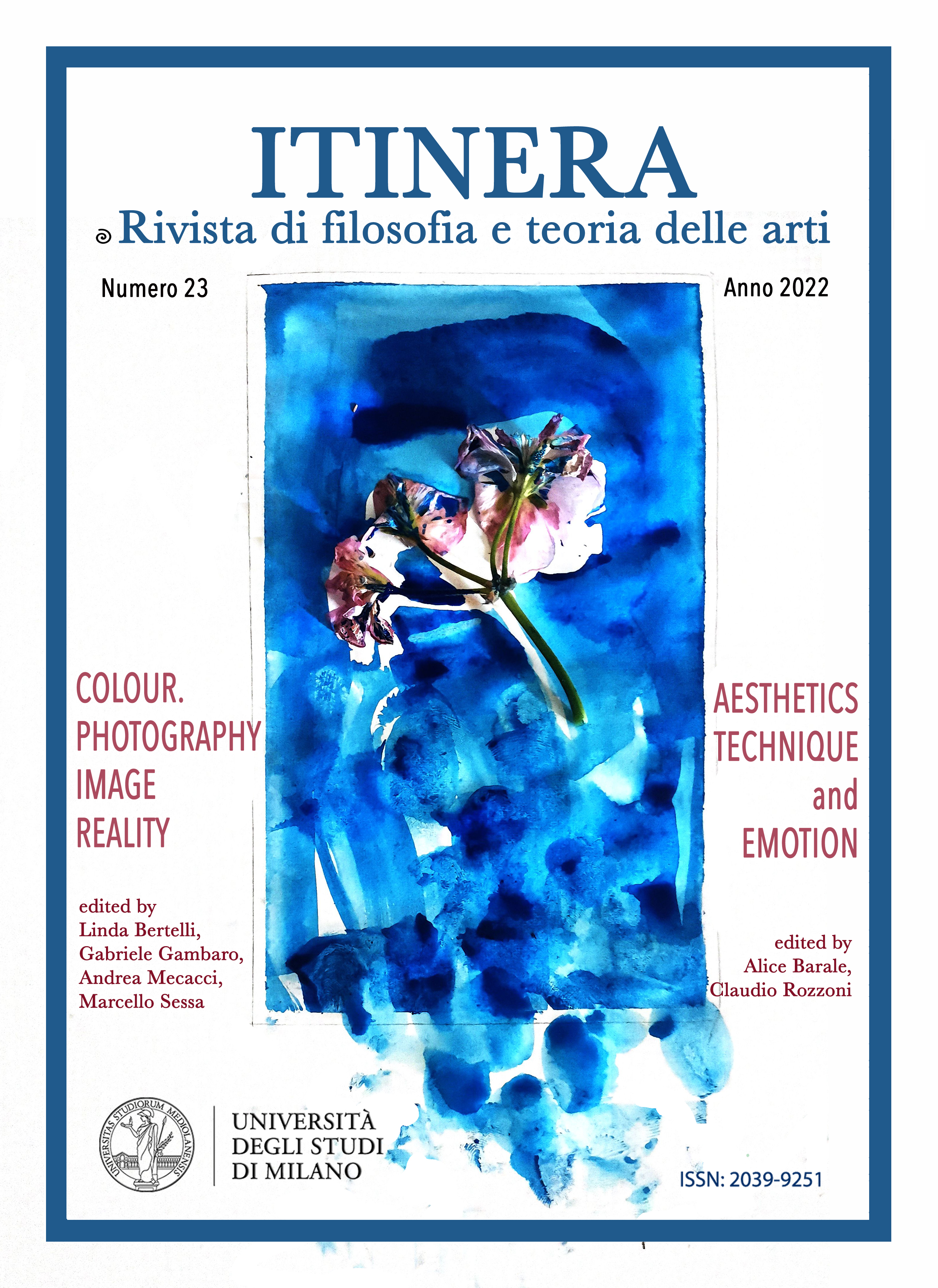The use of artistic and non-artistic images in contemporary culture: the thought of two contemporary philosophers (Jean Baudrillard and Mohamed Abed al-Jabri)
DOI:
https://doi.org/10.54103/2039-9251/18577Abstract
The main purpose of this research is to analyze and understand the use of artistic and non-artistic images between East and West and especially of images accompanied by words written in Arabic. In reality there is a lot of information, images and falsifying words, in fact as stated by the French philosopher Jean Baudrillard: "when the image cancels reality" it is our duty to interpret it and give it the right meaning (Jean Baudrillard, 1988). In this regard We can say with certainty that very often, when the images shown contain writings in Arabic or in other languages that are not well known in the West, the message may not be fully intelligible or decodable and this prevents the understanding of the images themselves which may mistakenly be deemed untrue. We live in the era of images, and since these dominate the panorama of the contemporary world at the level of science, culture, economy and media, today as never before they are so fundamental in political and social life. To better understand this phenomenon of dependence of individuals on technology, television, social networks and videos, we will use the methodology of interpretation that will allow us to analyze these phenomena and these means which, taken in themselves, have no negative or positive value, which however, they must be considered critically in order to be able to use them correctly and consciously. With this research I aim to establish a link between different cultures, to find a common thought and contribute to the formation of a society, united against violence and terrorism.
References
Abd al-Jabri, M., La ragione araba (1994), trad. it. di A. Serra, Giangiacomo Feltrinelli Editore, Milano 1996.
Alfieri, A., Violenza dell’immagine e immagine della violenza: Nancy, Deleuze, Baudrillard, 2016, URL:http://www.filosofia.it/archivio/index.php?option=com_content&view=article&id=361:violenza.
Bargna, I., Gli usi sociali e politici dell’arte contemporanea fra pratiche di partecipazione e di resistenza, in “Antropologia”, 13, 2011, pp. 75-106, URL: https://www.researchgate.net/publication/307778300_Gli_usi_sociali_e_politici_dell'arte_contemporanea_fra_pratiche_di_partecipazione_e_di_resistenza.
Baudrillard, J., Il sistema degli oggetti (1968), trad. it. di S. Esposito, Bompiani, Milano 1972.
Baudrillard, J., Lo scambio simbolico e la morte (1976), trad. it. di G. Mancuso, Feltrinelli, Milano 2015.
Baudrillard, J., Simulacra and simulation, Stanford University Press, Standford CA 1988, pp. 122-167.
Baudrillard, J., Il delitto perfetto. La televisione ha ucciso la realtà? (1995), trad. it. a cura di G. Piana, Raffaello Cortina Editore, Milano 1996.
Baudrillard, J., Il Complotto dell’arte (1997), trad. it. di L. F. Guarino, SE SRL, Milano 2013.
Baudrillard, J., Quando l’immagine cancella la realtà, in “La Repubblica”, 18/02/2009, URL: https://ricerca.repubblica.it/repubblica/archivio/repubblica/2009/02/18/quando-immagine-cancella-la-realta.html.
Baudrillard, J., Utopia delle immagini, atopie del reale, trad. it. di G. Crivella, in “Kasparhauser”, 14, 2016, URL: http://www.kasparhauser.net/periodici/14%20utopia/09-Baudrillard.html.
Debord, G., La società dello spettacolo (1967), trad. it. a cura di P. Salvadori e F. Vasarri, Baldini&Castoldi, Milano 2006.
Debray, R., Vita e morte dell’immagine. Una storia dello sguardo in Occidente (1992), trad. it. di A. Pinotti, il Castoro, Milano 1999.
Di Giacomo, G., La funzione dell’estetica moderna, in “Comprendere”, 18/2, 2016, pp. 55-70.
Di Stefano, E., Iperestetica, arte, natura, vita quotidiana e nuove tecnologie, Centro Internazionale Studi di Estetica, Palermo 2009.
Freccero, C., Immagine, realtà e filosofia, in “Italianieuropei”, 1, 2010, URL: https://www.italianieuropei.it/it/la-rivista/archivio-della-rivista/item/1526-immagine-realt%C3%A0-e filosofia.html.
Lamendola, F., Nell’era del virtuale, per Baudrillard, la realtà scompare e diviene il suo contrario, 2012, URL: https://www.ariannaeditrice.it/articolo.php?id_articolo=42089.
Lorber, M., Da Jean Baudrillard a Maurizio Cattelan: contesti, strategie fatale e iconologia della realtà dissolta, in “Arte in Friuli – Arte a Trieste”, 2009, pp. 245-270, URL: https://www.academia.edu/12362902/Death_of_a_Truth_DA_JEAN_BAUDRILLARD_A_MAURIZIO_C,ATTELAN_CONTESTI_STRATEGIE_FATALI_E_ICONOLOGIA_DELLA_REALT%C3%80_DISSOLTA.
Missaglia, N., Il “nuovo Averroismo” di Mohamed Abd al-Jabri, 2011, URL: https://www.resetdoc.org/it/story/il-nuovo-averroismo-di-mohammed-abed-al-jabri/.
Perniola, M., La società dei simulacri, Cappelli, Bologna 1980.
Tramontata, A., La dialettica dell’immagine terroristica: Baudrillard contro Baudrillard, in “Mediascapes journal”, 9, 2017, pp. 151-164, URL: https://www.researchgate.net/publication/321588212_La_dialettica_dell'immagine_terroristica_Baudrillard_contro_Baudrillard.
باللغة العربية: In lingua Araba
جان بودريار: المصطنع والاصطناع، ترجمة جوزيف عبد الله، مركز دراسات الوحدة العربية، الطبعة الأولى، بيروت، 2008، ص 15.
جان بودريار: الفكر الجذري أطروحة موت الواقع، ترجمة منير الحجوجي وأحمد القصوار, دار توبقال للنشر , الطبعة الأولى 2006.
محمد عابد الجابرى: التراث والحداثة, دراسات ومناقشات, مركز دراسات الوحدة العربية, الطبعة الأولى, بيروت, 1991.
محمد عابد الجابرى: نحن والتراث قراءة معاصرة فى تراثنا الفلسفى، بيروت، دار الطليعة، 1980.
Downloads
Published
Issue
Section
License
The authors who publish in Itinera are required to accept the following conditions:
1. The authors retain the rights on their paper and lincese the journal the right of first publication. The paper is also licensed under a Creative Commons License, which allows others to share it, by indicating intellectual authorship and its first publication in Itinera.
2. Authors may adhere to other non-exclusive license agreements for the distribution of the published version of the paper (ex. deposit it in an institutional archive or publish it in a monograph), provided that its first publication in Itinera is indicated.
3. Authors can disseminate their paper online (ex. in institutional repositories or on their website) before and during the submission process, since this can lead to productive exchanges and increase quotations of the published work (See “The Effect of Open Access”).





